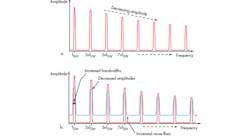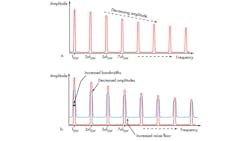Help!
Several years ago, when I wrote about a new product – a Class-D amplifier for headsets that relied on the inductance of the output cable to filter out the (dithered) harmonics of the device’s clock signal, I got an email from a reader, a senior RF guy, who took issue with the whole business of clock dithering.
As closely as I can recall the email, his beef was that we were, in general, “trading a few stationary birdies for a general rise, globally, across the whole noise floor.”
I keep thinking back to that email, especially when I hear about the FAA relaxing its rules about in-flight use of portable devices.
Here’s where I need help: I’m looking for readers’ comments on how seriously to take this issue. By myself, I know just enough to research and write reasonably interesting articles. I have an EE, I used to have a First Phone (before the FCC made that license obsolete), and I have an Amateur Extra -- all of which give me just enough of an RF vocabulary to ask semi-intelligent questions.
So here’s one: What if 300 people on an airplane are all using multiple gadgets, each of which raises the noise floor by just a little bit?
WHAT’S ALL THIS CLOCK DITHERING ANYWAY?
Here’s some background. We can talk about clocks in digital circuits, switch-mode power supplies, and certain audio amplifiers. In switching power supplies, the clock controls the rate at which the switching devices turn the current on and off. Class D amplifiers resemble power supplies in which the (supersonic) duty-cycle of the clock is varied as a function of the audio input. (Then the clock is filtered out, leaving the amplified audio.)
In both cases, the catch is that clock waveforms are essentially square waves; they create and radiate odd harmonics of their fundamental frequency.
WHY DITHER?
Among the myriad of Federal Communications Commission (FCC) regulations, there is one, Title 47, Part 15, Subpart B (Title 47 of the Code of Federal Regulations, Unlicensed Transmissions, Unintentional Radiators).
In essence, it says that if you want to build something that could generate RF interference, you have to test it, and, even though it’s not a radio per se, the RF it emits it still has to be below certain limits.
Paragraphs 15.109 of the document contain the radiated interference limits. Subparagraph (a) says, “(a) Except for Class A digital devices, the field strength of radiated emissions from unintentional radiators at a distance of 3 meters shall not exceed the following values:
|
Frequency of Emissions (MHz) |
Field Strength (μV/M) |
|
30-88 |
100 |
|
88-216 |
150 |
|
216-960 |
200 |
|
Above 960 |
500 |
There is also a standard for the actual process of measuring Part 15, Class B devices: ANSI C63.4-2003, “American National Standard for Methods of American National Standard for Methods of Measurement of Radio- Noise Emissions from Low-Voltage Electrical and Electronic Equipment in the Range of 9 kHz to 40 GHz,” It’s essentially about test equipment and procedures.
DITHERING = AVERAGING PEAK MEASUREMENTS
Apparently, what’s been inferred from these documents is that it’s okay to time-average field strength measurements.
Thus, if the harmonics being observed come from a clock whose fundamental frequency is constantly being swept across a certain range, the time-averaged value is less than any peak value. (At least, that’s how it has been explained to me many times.)
From which, I infer that, in some instances, peak values might have busted the spec if they stayed at one frequency. I also infer that because there are some dithering profiles that actually have IP patent protection.
BACK TO THE NOISE FLOOR
This brings me back to that email from the unhappy RF engineer. He was concerned about what happens when you rob Peter to pay Paul. (See the figure)
“Birdies” is an old term. I encountered it in my earliest ham days, when they were just whistles in my superhet receiver caused by the local oscillator or some other piece of equipment. You tuned them out with a variable audio filter, just like any other interference, and you got sore if they were covering up that guy on St. Helena you’d been trying to get in your log.
The noise floor was something different. If that guy in St. Helena was buried down under the noise, that was it. That feeling about the noise floor is also backed up by some of my early experience writing qualification-test reports at aerospace companies.
WHAT I WANT TO KNOW IS . . .
Should I be worried about this stuff? I accept that GPS is already working below the noise floor, thanks to the magic of autocorrelation, but is that good enough to deal with a Jumbo full of people, each with three or four pieces of personal electronics yodeling away during a tricky approach? Please tell me somebody really did some worst-case susceptibility testing with a bench full of laptops and cellular phones. If they did, what kind of safety margins did they find?
Thanks for your help.

